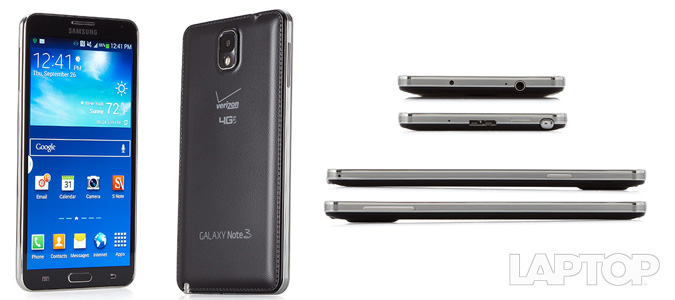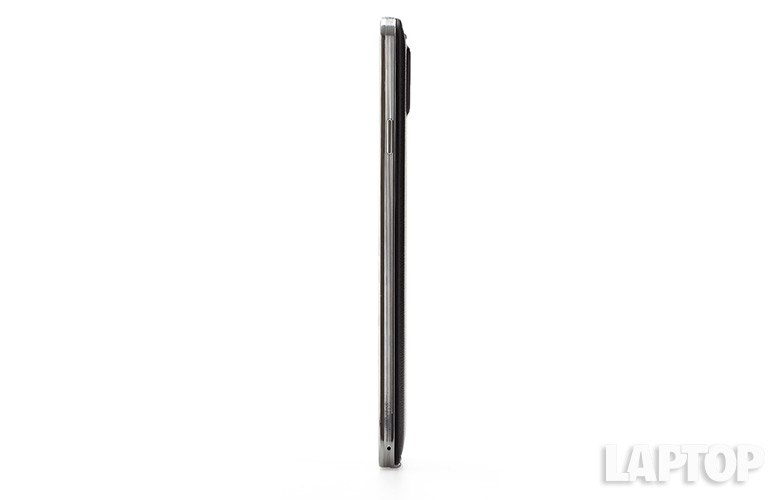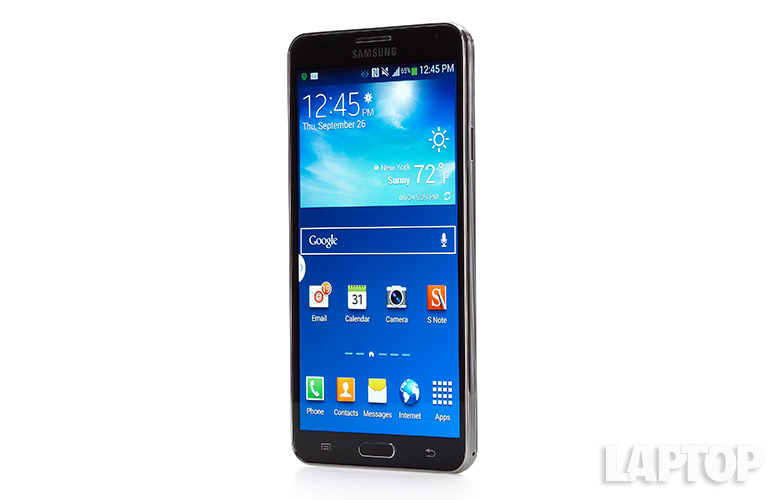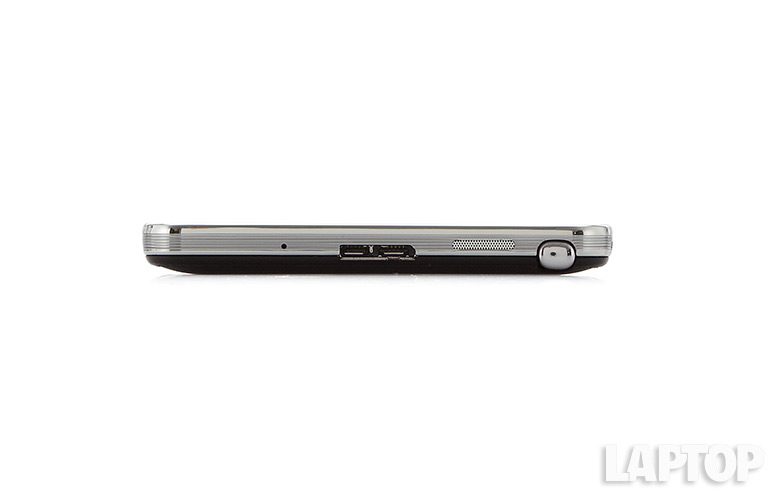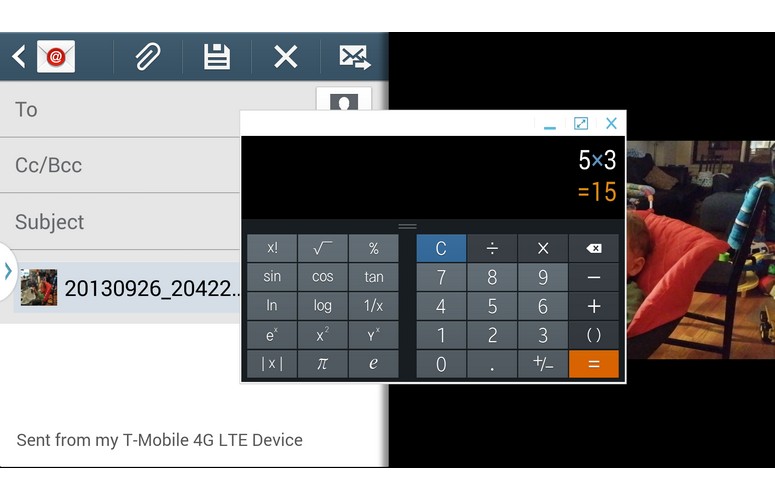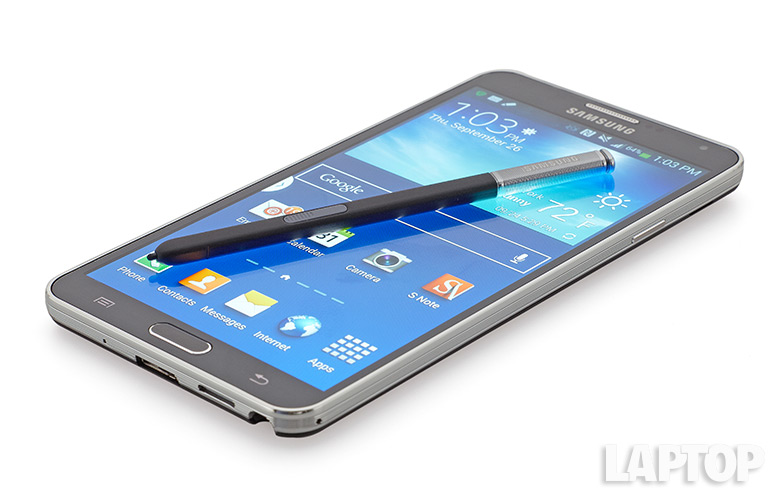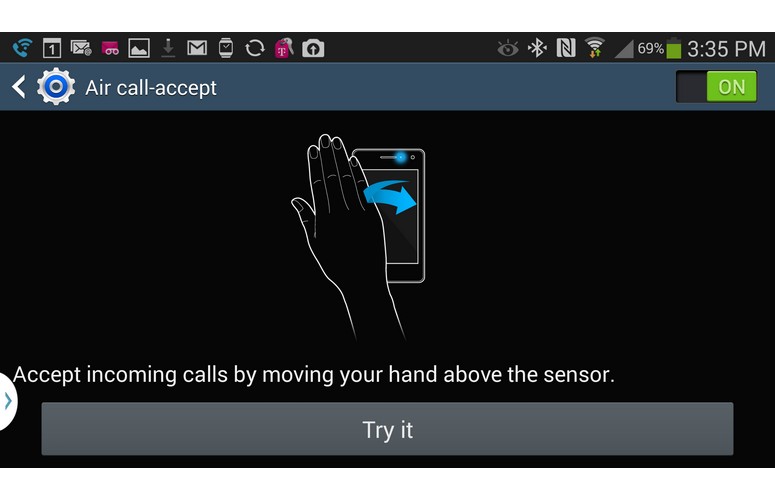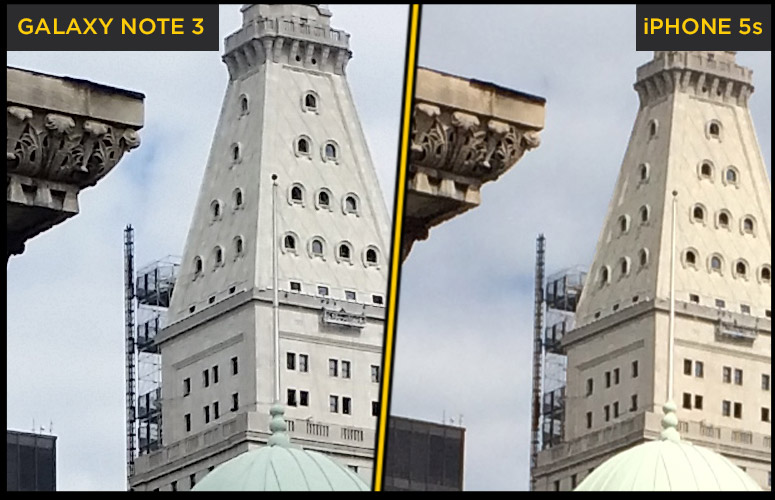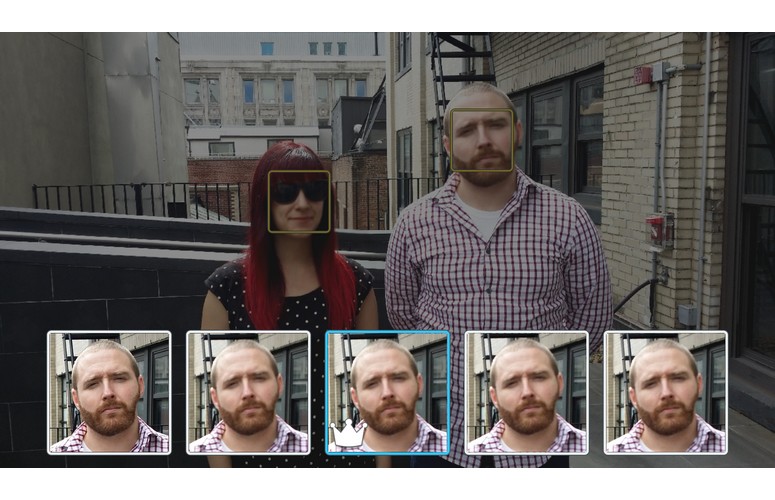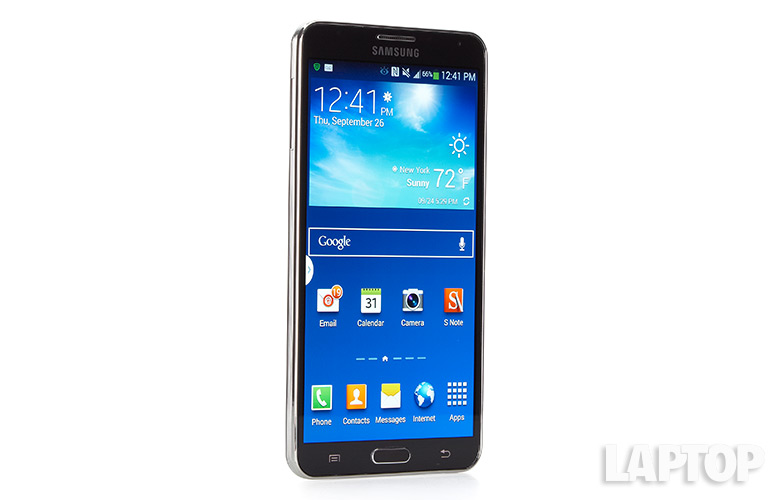Laptop Mag Verdict
With its big and bright display, long battery life and improved pen input capability, the Note 3 is the phablet to beat.
Pros
- +
Strong battery life
- +
Gorgeous full-HD screen
- +
Sharp camera
- +
Useful pen apps
- +
Powerful performance
Cons
- -
Not one-hand-friendly
- -
Aggressive crapware
- -
Inconsistent LTE performance
Why you can trust Laptop Mag
Now this is a phablet. Samsung's Galaxy Note 3 combines a gorgeous 5.7-inch full-HD display, a fast Snapdragon 800 processor and lots of improvements to the pen experience. It gets better. Verizon's version of the Galaxy Note 3 offers nearly 10 hours of nonstop use on our tests and is capable of next-generation AWS LTE speeds. Then again, the Note 3 is considerably larger than your average smartphone, and its $299 price is steep. But don't let those two caveats stop you.
Editor's Note: Portions of this review were adapted from our review of the Galaxy Note 3 for T-Mobile.
Design
Though it is one of the bigger phones on the market, the 5.95 x 3.12 x 0.33-inch, 5.9-ounce Galaxy Note 3 is a little thinner and lighter than its predecessor, the Galaxy Note 2 (5.9 x 3.2 x 0.37 inches, 6.3 ounces), despite having a screen that's 0.2 inches larger. It's also significantly smaller than the new 6.4 x 3.2 x 0.4-inch, 7.65-ounce HTC One Max.
The Note 3 was easy to grip in our hand and fit easily in our front pants pocket, but we found it way too wide for one-handed use. Users with small hands might prefer the smaller Samsung Galaxy S4 (5.31 x 2.69 x 0.25 inches, 4.6 ounces) or the HTC One (4.87 x 2.31 x 0.30 inches, 3.95 ounces).
Click to EnlargeIn a market where both Apple and HTC sell phones with attractive aluminum chassis, Samsung still uses plastic on high-end handsets such as the Galaxy Note 3. However, the Note 3, which is available in black or white, has faux-metal sides and a leatherlike back that lend it an air of sophistication missing from other Galaxy phones. Building with plastic has some advantages, as it allows Samsung to give the phone a removable back panel that provides access to the replaceable battery and microSD card slot.
The Note 3 is the first smartphone we've seen that uses a microUSB 3.0 port for charging and data transfer. When we plugged the device into a USB 3.0 port on our PC, the phone prompted us to choose between USB 3.0 mode and USB 2.0 mode, with USB 3.0 mode requiring the phone to drop all wireless connections and go into Airplane Mode. We chose USB 3.0 mode, and transferring files with our PC was lightning fast. We were also able to charge the phone with a standard microUSB 2.0 cable.
Sign up to receive The Snapshot, a free special dispatch from Laptop Mag, in your inbox.
Display
Click to EnlargeThe Galaxy Note 3's 5.7-inch, 1920 x 1080 display is one of the brightest and most vibrant we've seen, making it readily viewable in direct sunlight. At 555 lux on our light meter, the AMOLED panel is easily ahead of 396-lux category average, the 460-lux Galaxy S4, the 439-lux HTC One and the 500-lux iPhone 5s.
MORE: Hyperion Extended Battery Nearly Doubles Battery Life of Galaxy Note 3
When we played a 1080p trailer for "The Avengers" on the Galaxy Note 3, images were bright and sharp from all viewing angles, even 90 degrees to the left or right. We compared the phablet's output to the same clip on the Galaxy S4, and the image was markedly brighter and more colorful.
Audio
Click to EnlargeWhile good enough for watching video clips or conducting speakerphone calls, the Galaxy Note 3 provides tinny, lifeless music playback from its speaker. When we played the Beastie Boys' "Fight for Your Right to Party," the vocals were drowned out by the rough metallic sound of the guitar and drums. At 79 decibels on our sound meter, the Note 3 is just slightly quieter than the 80 dB smartphone category average, but on a par with the LG G2 (79 dB).
Operating System
Click to EnlargeThe Galaxy Note 3 comes with Google's latest Android 4.3 operating system, covered over by the newest version of Samsung's TouchWiz skin. As with other TouchWiz phones, the Note 3 has icons on its six home screens and an app drawer that look like they are floating on top of the blue-sky wallpaper and gradient-blue background.
If you're bored of looking at a traditional Android desktop with icons and widgets, swipe up, and you can see a new home-screen feature called My Magazine, which shows a giant, customizable news feed filled with pictures. The software is based on Flipboard, and looks and feels a lot like both the popular app and HTC's BlinkFeed home screen. If you enjoy news feeds with lots of big pictures, My Magazine is definitely worth a look.
MORE: 12 Worst Android Annoyances and How to Fix Them
Like other Samsung phones, the Note 3 has a comprehensive Quick Settings menu that appears when you pull down the notification drawer, and lets you control the brightness and toggle 20 different settings, ranging from Bluetooth to gesture control. With a settings change, the lock screen can show five quick shortcuts.
Like the T-Mobile version of the Galaxy Note 3, Verizon's implementation fits all of its apps on one screen by burying more than two dozen additional icons into dedicated folders. We were happy that the phone collects all of Verizon's utilities under a single folder, though it adds another folder of Amazon crapware. The Google folder contains most of the really important Google apps and services, including Chrome, while the Samsung folder holds useful utilities such as S Health, S Voice and WatchOn.
Multi Window Mode
Click to EnlargeMulti Window mode is one of our favorite Samsung features, because it provides the desktoplike experience of placing two apps side by side. With the Note 3, Samsung has added the ability to place two windows from the same app next to each other, which was particularly useful when we wanted to look at two Web pages at the same time. A new context menu that appears as a blue dot between the two windows allows you to enable drag-and-drop. This allowed us to grab an image out of the gallery on the left side of our screen and drag it into the Samsung Email app, where it became an attachment in a message we were editing. (We wish we didn't have to press a button first, but this function still works as advertised.)
Using the new Pen Window function, which allows you to open one of a few select apps in a floating window, we were able to place a third window on top of the split screen. Among the eight apps that support this feature are Calculator, Clock, YouTube and Internet.
Keyboard
Samsung's virtual keyboard is among the most comfortable you'll find on any Android phone, and it works even better on the Note 3's 5.7-inch screen. Widely spaced keys made it easy for us to avoid hitting adjacent letters by accident; the dedicated number row saved us many mode switches, and the optional haptic feedback made it feel more like we were pressing hardware keys.
Based on the popular SwiftKey third-party keyboard, but with a unique design and layout, the Samsung keyboard learns from your typing habits and offers really strong next-word predictions. The keyboard also provides trace typing for those who like to form words by drawing between letters. A highly accurate handwriting mode let us draw words with the stylus and watch as they turned into on-screen ASCII text.
Pen Experience and Apps
Click to EnlargeIt wouldn't be a Galaxy Note without its stylus and host of powerful pen-friendly apps. The Note 3's lightweight, 0.1-ounce stylus was easy to grip between two fingers, and its flexible tip made rubbing against the glass screen feel a lot like pushing a ballpoint pen against paper.
Removing the stylus from its bay or clicking its single button while hovering above the display brings up Samsung's new Air Command menu, which offers five different pen-friendly utilities: Action Memo, Scrapbooker, Screen Write, S Finder and Pen Window.
Action Memo creates virtual sticky notes that can be stored or minimized so they stay pinned on your screen wherever you go. When you draw a lasso or a circle around the text in an action memo, the application interprets your handwriting and gives you the option of dialing what you've written (if it's a phone number), mapping it (if it's an address), adding it to contacts, emailing it, sending it as an SMS message or adding it to your task menu.
Click to EnlargeThough the handwriting recognition in Action Memo was generally good, it didn't always provide enough accuracy for us to perform one of these actions based on our messy scribbles. When we wrote "Buy Milk" and tried to turn those words into a task, the app turned them into two tasks: "buy" and "milk." However, when we carefully wrote a phone number in better handwriting, the app converted all the numbers correctly and allowed us to add the number to our contact list.
Scrapbooker allows you to draw a box around any content you see on the screen and save it to a scrapbook, along with any associated metadata, a custom memo, and tags to help you find it later. When we drew a box around a picture of a home on a real-estate website, Scrapbooker stored not only the photo, but also the URL of the page, so we could visit it again later. When we drew a box around an area of a Google map, Scrapbooker stored an image of the surrounding streets and the address, but not a link back to the Maps app.
Screen Write simply takes a shot of the entire screen and then allows you to scribble on top of that shot and save or share the result.
Click to EnlargeS Finder provides a powerful internal search engine that allows you to search all of your recent activities by keyword, pulling up emails, scrapbook entries, videos you've watched and Web pages you've visited. When we tagged a scrapbook page with the word "house" and then entered that term as a keyword, the page appeared as a result. The engine even searches through handwriting in notes, as shown when it found the text "ABC" in one of our Action Memos, even though this handwriting had not been translated to ASCII. Better still, if you don't enter any terms, you can see a list of all your activities from today, yesterday, the past seven days or the past 30 days.
For the Galaxy Note 3, Samsung also updated S Note, its powerful note-taking app. In addition to a new, clean, white design and the ability to sync with Evernote, S Note has a new feature called Easy Chart, which allows you to create bar, line or pie charts just by sketching. However, we found it hard to get precise numbers and wished we could import data from one of our existing spreadsheets. As in earlier versions, the new S Note allows you to create notebooks and write on a series of background templates, such as a picture diary, checklist or ruled paper. You can translate your scribbles into ASCII text, make them into vector graphics or even evaluate them as mathematical formulas.
S Note also allows you to insert video, maps, voice memos or photos into your notes. The app even provides a record feature, which allows you to capture and playback all of your strokes and scribbles in the order in which you drew them. However, we liked S Note best when we were simply scribbling notes in a meeting, as it felt like we were using a real paper notepad.
The phone also includes SketchBook for Galaxy, a fairly advanced drawing app that allows you to choose from dozens of different brushes, add text to your drawings, use gradients or include clip-art symbols. The Pen.Up app showcases the best drawings made by Galaxy Note users.
Bundled Apps
Click to Enlarge
In addition to the pen software that's made just for Galaxy Notes, Samsung includes a number of its proprietary apps found on other Galaxy phones. S Health keeps track of your fitness, recording how many steps you've taken each day and helping you move toward your goals. KNOX provides a separate environment for business apps and data -- a feature that many companies use as part of their BYOD (bring your own device) strategies. S Translator helps you conduct a foreign-language conversation by translating another person's voice into English text and your voice into another language. However, it is awfully similar to Google Translate.
Using the Galaxy Note 3's infrared port, WatchON enables you to turn the phone into a smart remote control; you can change channels on your TV and find videos online to watch. Group Play empowers you to stream content to friends in the same vicinity and even lets you all play the same song at the same time. Story Album turns your photos into printable or browsable albums. Surprisingly, on the Note 3, Samsung does not include Optical Reader, an app on the Galaxy S4 that takes pictures of business cards and adds them to your contacts.
Verizon piles on more than its fair share of crapware and promotions for expensive services. VZW Navigator costs $4.99 a month and offers the same kind of turn-by-turn directions you can get for free from Google Maps. NFL Mobile offers the ability to view live games for $4.99 a month. Verizon Tones sells ringtones for $1.99 and up, though you could easily use your own MP3 files to create a ringtone. The carrier also throws in a full folder of Amazon apps that you can install on your own, including Kindle reader, an Amazon.com shopping app and an MP3 marketplace.
Verizon's Caller Name ID is one of the most obtrusive preloaded apps we've ever encountered. The app automatically signs you up for a free trial of a $2.99 monthly service that tries to give you more information about the caller, such as his or her name and photo. However, sometimes, it just shows the number.
Gesture and Eye Control
Click to EnlargeLike the Galaxy S4, the Note 3 supports several types of eye and gesture controls, some of which feel more like parlor tricks than helpful features. Smart Scroll moves up and down Web pages when you raise or lower your gaze, while Smart Pause stops video playback when you move your eyes away from the screen. Air Call Accept lets you answer a call by waving your hand in front of the screen, while Air Jump lets you scroll Web pages with a wave. Air Browser allows you to cycle through images in the gallery by waving your hand from side to side in front of the screen.
Air View
Click to EnlargeLike its predecessor, the Galaxy Note 3 offers Air View previews when you hover your pen over certain content. We appreciated being able to see thumbnails of all the images in a gallery, or the text of an email in the inbox, by placing the stylus tip above the screen. If you change a setting under the Motions and Gestures section of the Settings menu, you can also use Airview with your finger.
Performance
Click to Enlarge
With its quad-core Qualcomm Snapdragon 800 CPU and 3GB of RAM, the Galaxy Note 3 provides performance that's good enough for high-end gaming or any other app you throw at it. Full-HD movies were smooth as butter, while the Jet Ski racing game "Riptide GP 2" provided high frame rates and attractive special effects. However, Samsung's apps can be sluggish and mar the experience, as the mail client took more than two seconds to open a new Compose Email window, while the same action took less than a second in Gmail and on the HTC One.
On Geekbench 3, a synthetic benchmark that measures overall performance, the Verizon Galaxy version of the Galaxy Note 3 scored a strong 2,883, which is nearly double the smartphone category average of 1,603 and much stronger than the LG G2 (1,595) and Apple iPhone 5s (2,556).
The Galaxy Note 3 also returned an impressive score of 18,321 on the 3DMark Ice Storm Extreme graphics benchmark, which is nearly double the 9,725 category average and way stronger than the LG G2 (15,574) and iPhone 5s (13,795).
Battery Life
Click to EnlargeThe Verizon version of the Galaxy Note 3 lasted an impressive 9 hours and 57 minutes on the LAPTOP Battery Test, which involves continuous surfing over 4G LTE at 40 percent brightness. That time is more than 50 percent longer than the 6:27 smartphone category average and nearly double the Verizon Galaxy S4's time of 5 hours and 25 minutes. This runtime even bested the much-dimmer-screened LG G2 on Verizon (9:14) by 43 minutes. However, perhaps due to its network, the T-Mobile version of the Galaxy Note 3 lasted an even longer 11 hours and 15 minutes.
MORE: 10 Smartphones with the Longest Battery Life
Camera
The Samsung Galaxy Note 3's 13-MP rear camera took sharp, colorful images that compare favorably to those taken on the HTC One and iPhone 5s. When we shot images of a tree on our office roof, the leaves and surrounding grass looked sharper and more lifelike than on the iPhone's 8-MP sensor or the One's 4-MP shooter
Click to Enlarge
When we zoomed in on a photo of a building, the differences between the two cameras were even starker. The spire at the top of the building appeared blurry on the iPhone's shot, while the Galaxy Note 3's picture showed additional lines and textures. Colors were generally richer and more saturated on the Note 3 than on the iPhone 5s, though some users may find the iPhone's colors more accurate, depending on the scene.
When we shot a 1080p video of cars driving down a street, images were equally sharp, and colors like the yellow on cabs and the blue on a bus really popped. The Note 3's 2-MP, front-facing camera also captures high-quality photos. An image of our face that we shot in a shadowy area was still bright, and showed every follicle in our beard.
[sc:video id="N2cHE1cTrq2hBQvl2CWhX00mHQM7pC4P" width="575" height="398"]
Camera Software
Click to EnlargeLike the Galaxy S4, the Galaxy Note 3 has a slew of custom camera features, many of which are extremely useful and fun. The Eraser feature automatically filters out strangers who walk through your frame when you are shooting in public. Drama Shot takes a series of photos and stitches them together to show a person or object moving through the scene.
Best Face takes several shots of a group of people and allows you to choose the best head for each, while Best Shot just lets you choose the best photo from a burst. Dual Camera mode allows you to shoot stills or video with both lenses at once, placing an image of your face in a box on top of the primary photo. We particularly enjoyed Animated Photo Mode, which we used to create animated GIFs of a toddler doing goofy things.
4G LTE Speeds
Click to EnlargeThe Galaxy Note 3 rides on Verizon's large 4G LTE network and supports its new AWS bands, which promise faster speeds. Unfortunately, Verizon's performance varied widely within a space of a few blocks. In a New York apartment on the east side of the city, we got impressive transfer rates as high as 51.8 Mbps down and 9 Mbps up, more than double the speed of our home Internet connection. However, when standing across the street from the Empire State Building, we saw 3 out of 5 bars of 4G but got awful transfer rates of 1.25 Mbps down and 0.24 Mbps up. The performance was even worse on 23rd Street and 6th Avenue, where the phone's status bar displayed 4 out of 5 bars of 4G, but we got just 0.04 Mbps down and 0.59 Mbps up.
Call Quality
Calls sounded sharp and clear, both on the speakerphone and when we held the Note 3 up to our ear. The people on the other end of the phone reported that our incoming audio was equally audible.
Value
To get the Galaxy Note 3 at its subsidized price of $299, new users must sign a two-year contract for Verizon's Share Everything plan, which charges $40 for unlimited talk and text on the phone, plus $60 for 2GB of data -- a total of $100 per month, or $2,700 over 24 months (including the price of the device). You can economize a little by purchasing 1GB of data for $50 a month ($90 total) or get 4GB of data for $70 a month ($110 total). In comparison, T-Mobile charges $60 a month in total for 2.5GB, but makes you pay the full $700 for the phone in monthly installments, for a total of $2,140 over 24 months.
AT&T also charges $299 for the Galaxy Note 3, but its plans start at $39.99 for 450 minutes, $20 for unlimited text messaging and $30 for 3GB of data, $90 per month. The company also has a share plan that costs $95 per month for 2GB of data plus unlimited talk and text for a total of $2,580 over two years. Sprint charges just $249 for the phone and either $110 per month for unlimited data plus hotspot usage ($2,640 over 2 years) or $80 for unlimited talk, text and data without hotspot ($2,160 over 2 years).
Verdict
Click to EnlargeWith its nearly 10 hours of battery life, big and bright screen, sharp camera and powerful software, the Galaxy Note 3 is the ultimate high-end smartphone. Consumers looking for a smaller device on Verizon should consider the 5-inch Galaxy S4, 4.7-inch HTC One or the 4-inch iPhone 5s. Those looking for lower rates should consider T-Mobile or Sprint, which have smaller LTE footprints but charge a lot less per month. However, if you want the most versatile phone on Verizon's LTE network, look no further than the Samsung Galaxy Note 3.
Samsung Galaxy Note 3 (Verizon) Specs
| Alternate Carriers | Sprint, AT&T, T-Mobile |
| Brand | Samsung |
| CPU | Quad-core Qualcomm Snapdragon 800 CPU |
| Camera Resolution | 2 MP |
| Carrier | Verizon |
| Company Website | http://www.samsung.com |
| Data | LTE |
| Display (main) | 5.7 inches |
| Display Resolution | 1920x1080 |
| Form Factor | Candy Bar |
| Front Camera Resolution | 13MP |
| GPS | Yes |
| Internal Memory | 16GB |
| Memory Expansion Type | microSD Card |
| Networks | LTE 800 / 850 / 900 / 1800 / 2100 / 2600 - N9005 |
| OS Family | Android |
| Operating System | Android 4.3 |
| Phone Display Size | 5.7 |
| Ports | 3.5mm headphone, microUSB |
| Processor Family | Qualcomm Snapdragon 800 |
| RAM | 3 GB |
| Size | 6.0 x 3.1 x 0.3 inches |
| Weight | .37 pounds |
| Wi-Fi | 802.11 a/b/g/n |

